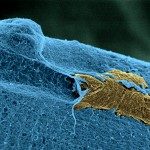Link to Pubmed [PMID] – 23469251
PLoS ONE 2013;8(3):e57894
The PB1-F2 protein encoded by influenza A viruses can contribute to virulence, a feature that is dependent of its sequence polymorphism. Whereas PB1-F2 from some H1N1 viruses were shown to exacerbate the inflammatory response within the airways, the contribution of PB1-F2 to highly pathogenic avian influenza virus (HPAIV) virulence in mammals remains poorly described. Using a H5N1 HPAIV strain isolated from duck and its PB1-F2 knocked-out mutant, we characterized the dynamics of PB1-F2-associated host response in a murine model of lethal pneumonia. The mean time of death was 10 days for the two viruses, allowing us to perform global transcriptomic analyses and detailed histological investigations of the infected lungs at multiple time points. At day 2 post-infection (pi), while no histopathological lesion was observed, PB1-F2 expression resulted in a significant inhibition of cellular pathways involved in macrophage activation and in a transcriptomic signature suggesting that it promotes damage to the epithelial barrier. At day 4 pi, the gene profile associated with PB1-F2 expression revealed dysfunctions in NK cells activity. At day 8 pi, PB1-F2 expression was strongly associated with increased transcription of genes encoding chemokines and cytokines implicated in the recruitment of granulocytes, as well as expression of a number of genes encoding enzymes expressed by neutrophils. These transcriptomic data were fully supported by the histopathological analysis of the mice lungs which evidenced more severe inflammatory lesions and enhanced recruitment of neutrophils in the context of PB1-F2 expression, and thus provided a functional corroboration to the insight obtained in this work. In summary, our study shows that PB1-F2 of H5N1 HPAIV markedly influences the expression of the host transcriptome in a different way than its H1N1 counterparts: H5N1 PB1-F2 first delays the initial immune response but increases the pulmonary inflammatory response during the late stages of infection.

